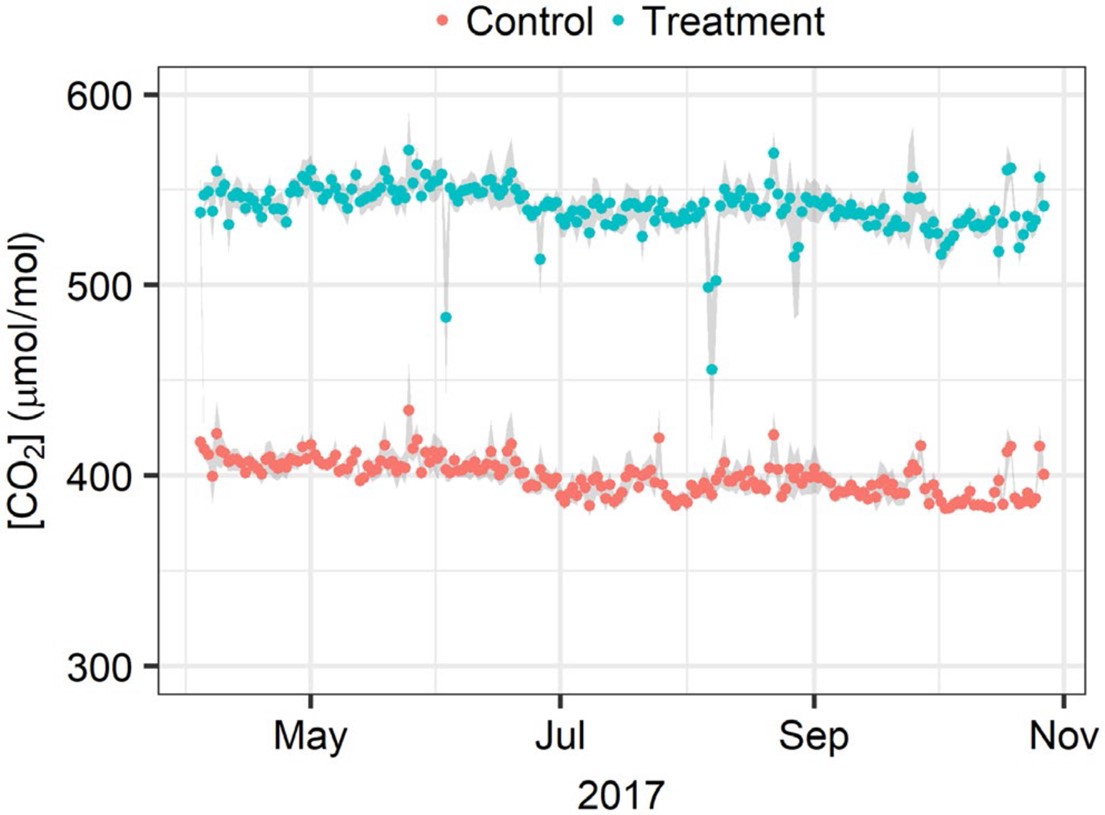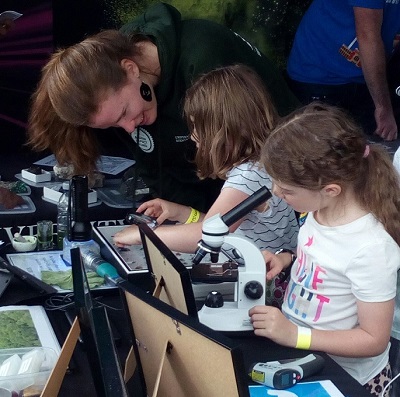Signal as well as substrate
by Prof Christine Foyer, Professor of Plant Sciences, School of Biosciences,
Increasing global Carbon Dioxide (CO2) has profound consequences for plant growth and productivity. The beneficial - ‘fertilisation’ - effects of CO2 could result in significant yield gains for C3 plants (including virtually all trees). However, increased CO2 comes with climate change, increasingly frequent heatwaves, and changes in rainfall patterns. Such climate factors will likely decrease productivity and yield. Predicting the overall outcome remains extremely challenging.
Increased CO2 alters the balance of photosynthesis and photorespiration in C3 plants, changing primary metabolism. The impacts on stress resistance are less clear; there is no consensus on whether elevated CO2 constitutes a stress in C3 plants. Although high CO2 increases yield, it can also increase cellular oxidation and activate defence pathways. Acclimation to high CO2 has been considered largely in terms of altered carbon gain, but emerging evidence, including from my own lab, suggests that CO2 is a signal as well as a substrate.
CO2-dependent induction of innate immune defences in plants is likely to be largely independent of primary metabolism. The unexpected consequence of increasing global CO2 is that plant defences against pathogens and pests may be increased, at least in some species. If higher CO2 activates innate immune responses in trees, this may offset predicted increases in insect population growth and metabolic rates. Further studies are vital to understand how trees will respond to the challenges and unexpected benefits of a high-CO2 future.
Photo credit: Prof David Maddison (University of Birmingham) taken on his visit to a Bristlecone Pine Forest in California. These trees are some of the oldest living things on the planet.
Tickets now available
The BIFoR 4th Annual national community meeting, will be on 29 & 30th January 2020 at the University of Birmingham. Find out more information and book tickets at www.birmingham.ac.uk/BIFoRCom20
Future Research
Predicting future rates of climate change is currently difficult as the models used don’t always agree with each other concerning how much the land will continue to lock down. To determine how a mature temperate forest responds to rising atmospheric CO2 a new 5 year, £3.7 million NERC funded research project called QUINTUS gets underway in October 2019. The QUINTUS project brings together 19 project partners who will carry out detailed measurements of nutrient cycling (more than 20,000 analyses) over a 5 year period.
In addition a NERC standard grant, “FACE Underground” awarded in June 2019, scoring 10/10 will provide mechanistic detail to complement the budget analysis in the QUINTUS Large Grant, and the food web analysis in the Fast-C standard grant led by Dave Johnson (University of Manchester).

New appointments
In January 2020, Prof Rob Jackson will join us as the Chair in Tree Pathology. He is a renowned plant biologist and specialises in the study of the interaction between microbes and plants.
Recent additions to our team also include Prof Christine Foyer (Professor of Plant Sciences), Dr Andrew Plackett (Research Fellow Biosciences) and Dr Thomas Welch & Dr Rosa Sanchez-Lucas (both postdoctoral researchers Biosciences). We also warmly welcome Dr Liz Hamilton (Geography).
Research highlight: Characteristics of free air carbon dioxide enrichment at BIFoR FACE
This paper reports the behaviour of CO2 in the BIFoR FACE facility. It demonstrates that in its first year of operation, 2017, the facility successfully delivered an extra 147(±21) parts-per-million (or μmol/mol) of CO2 to the treatment patches of forest for 98% of the scheduled operating time (see figure). Contamination of the control patches occurred less than 1% of the time. The results presented provide confidence that BIFoR FACE is operating well in excess of expectations. Paper: Hart, K. M. et al. Global Change Biol., doi:10.1111/gcb.14786.

Thinking Higher: towards biosecurity of forest trees
The Thinking Higher conference took place on the 11th July 2019. The event gathered over 80 attendees from different research and governmental institutions. This conference was based on the scientific topic of forest tree pathology and brought together speakers from 8 different European countries with the overall aim of promoting global biosecurity of forest trees. This event provided the ground for collaboration between groups from leading European institutions and major British scientific organisations, such as the University of Birmingham (host), Forest Research, the University of the West of England, the University of Oxford and the centenary institution Kew Gardens.
Doctoral research
Joining our team of 19 doctoral researchers this year are 4 further students under the Forest Edge Doctoral Scholarship Programme. Their research will address very topical areas including the impact of forest roads & forest fires and the impact of elevated carbon dioxide levels on volatile organic compounds released by plants & greenhouse gas emissions from soils now and in the future higher CO2 conditions.
Laura Brammeld, supervised by Dr Christian Pfrang
Bradly Deeley, supervised by Dr Natalia Petrovskaya
Nine Douwes Dekker, supervised by Dr Sami Ullah
Maria Gonzalez-Valencia, supervised by Prof David Maddison
We also welcome Lavinia Georgescu, supervised by Dr Tom Pugh and Dr Tom Matthews and Sophie Mills supervised by Prof Francis Pope.
Student engagement flourishes
Over the past 2 years 2,200 hours of volunteering have been recorded. This summer has been especially busy with many students getting involved with field research at the BIFoR FACE facility and lab-based work on campus. The team of summer interns pictured above surveyed over 7,000 trees, recording the species and scoring the disease (on scale of 1 to 8) on incidence of Chalara & powdery mildew.
Deemah Ziari, an A level student, who completed a summer placement as part of the Nuffield Foundation Summer Placement scheme, said “it was extremely entertaining and engaging; I’ve discovered much about trees and their significance to the environment and us, in particular, the different diseases that affect them which puts them at risk.
Mattie Park, a 2nd year Geography student said, “The experience at BIFoR will help me going forward in the fieldwork aspect of my degree and enhanced my knowledge of tree types and invasive species”
Community Volunteers
Special thanks go to our volunteers from Norbury, who helped with spring observations of seasonal changes in the woodland. This wonderful team (including children) visited designated spots within the BIFoR FACE weekly in the Spring and carefully recorded when they saw differences. For example first flush of oak leaves, first bluebell. If you live near Norbury, Staffordshire and could commit to volunteer for an hour a week during spring 2020 and would like to help continue with these observation recordings please do get in touch. Please note this would have to be during a weekday as the site is closed on weekends.
Hold the dates: 1st to 2nd July 2020
Treescapes 2020A doctoral led conference bringing together doctoral researchers and practitioners, covering 3 key themes of Growing Trees/Future Forests and the relationship between forest sciences and industry
Forests Count
The message of the importance of forests continues to pushed out thanks to our team of outreach volunteers. We particularly enjoyed this years CoCoMad festival. A highlight was the fascination on children’s faces as they discovered the importance of deadwood in a forest & seeing a psuedoscorpian under a magnifying glass.
